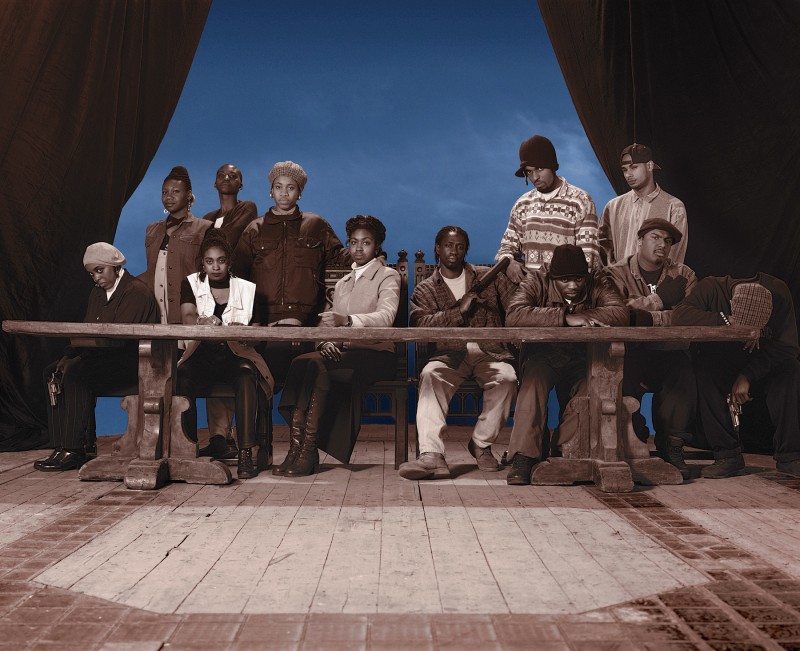
Pigmented inkjet print
59 x 72.5 in
Edition of 3
Born in London in 1969, Faisal Abdu’Allah is a British artist whose work primarily evolves from the interface of photography, the printed image and lens-based installation. He constantly repositions values and ideologies pertaining to representation. Abdu’Allah is a senior lecturer in Fine Art at the University of East London. He lives and maintains a studio in London.
– Artist’s website
* * *
The Last Supper depicts the last moments before the ultimate betrayal of Christ. This was the feast at which Jesus broke bread, poured wine and prepared his Disciples; in full knowledge of his fate and that his suffering was the only path to salvation for humanity. He knew that his betrayer sat at his table. The image of the Last Supper remains one of the most iconic in the annals of art within the Christian world. It is the final moment of both unease and repose, an event charged with trepidation and treachery giving way to both fear and faith. It is most famously portrayed perhaps in Leonardo Da Vinci’s composition on the walls of the Church of Santa Maria delle Grazie in Milan in the late fifteenth century. The scene is often characterized by a long table in the foreground laden with food, with Christ seated centrally surrounded by the Disciples in various states of anger and anguish. The traitor, Judas is typically seen in shadow or turning from the scene unable to hide his complicity in Christ’s fate.
Compositional familiarity works to disarm the viewer in Abdu’Allah’s diptych, The Last Supper I and The Last Supper II. In The Last Supper I, a central figure appears to assume the position of Jesus, his right hand invoking the Old Believer gesture for the sign of the cross. To his left, other men in white appear to reason with and question him whilst to his right and to his rear, veiled women look on, bereft. One woman spies a potential assassin standing to the right, his back to the viewer and his left hand displaying his weapon. Her wide-eyed stare intensifying a moment already balanced on a knife-edge. The assumption would be the assassin is Judas, yet Abdu’Allah refuses to confirm this definitively. The image invites the viewer to look closer and ask what else could be concealed in those robes, under those veils or behind those backs by anyone of those figures?
Firearms remain prominent in The Last Supper II where white robes and religious garb are replaced by contemporary clothes in which the actors, almost unanimously, turn away from the internal interaction and return the gaze of the viewer. This sacred scene so often scrutinized looks back at us in Abdu’Allah’s depiction of it, the heavy table on which the holy feast would be laid providing a barrier between their space and ours. This table bisects the composition, separating upper and lower bodies also between the spaces of display and of concealment, of weapons seen and unseen and of loyalty and disloyalty.
In Last Supper I and Last Supper II Abdu’Allah plays with our assumptions. After all, we know what happens next, but is this the case? We assume that as in the biblical narrative Christ is betrayed. Yet Abdu’Allah’s shoot is staged with live actors who have real lives. The stage lights that were used as the set of the photo shoot are switched off and the actors in these compositions go home. Yet these are not actors. The men and women depicted here are Abdu’Allah’s friends. They wear their own clothes and the white robes are those that they wear regularly to Mosque. The weapons, also, are theirs.
Working with Kofi Allen, Abdu’Allah presents the final works as large photographs. […] These images exude an air of documentary yet are neither fact nor fiction. Here in Abdu’Allah’s rearticulation are presented twelve young Muslim men and women reenacting Christ’s iconic final feast. The blonde haired, blue-eyed protagonist is replaced as is is the privileged state of detached omniscience afforded the viewer by previous artists of this iconic scene. Just as Abdu’Allah practice overlaps into their lives, so our presence is sutured into a lingering moment. The insertion of firearms used for offence and defense upset the well-known narrative. A simultaneous sense of confrontation and suspicion ensues in which the viewer is inescapably implicated. Assumptions based on clothing, skin color and faith unravel, and a familiar composition is destabilized fundamentally.
– Rachel Newman in “The Art of Dislocation,” pp. 26-27; OrbisAfrica Graphic Writing Systems lab and the Stanford Department of Art and Art History, CA, 2010
show prices
Prices and availability are subject to change without notice.The copyright of all art images belongs to the individual artists and Magnolia Editions, Inc.
©2003-2026 Magnolia Editions, Inc. All rights reserved. contact us
